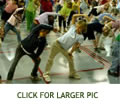|
FEEDBACK
FROM OTHER PROFESSIONALS:
GAY
TIMKEN - professor at Western Oregon University:
Gay Timken teaches up-and-coming college students how to become
physical education teachers. Here are some of the questions that
were asked:
Interviewer:
How does TEAM Time affect behavior management in the classroom?
Timken:
I have never directly observed anything, but anecdotally I hear
that students are more ready to learn in the classroom - that is,
they are more calm and able to listen. This doesn't necessarily
address behavior management, however. I think Meg, or one of her
teaching colleagues (i.e., elementary teacher) might be better able
to answer this. Observing TEAM Time and then subsequent
physical education classes, I can say that Meg still has to handle
behavioral situations.
Interviewer:
Have test scores changed at all?
Timken:
What I do know is that scores are at, or near, 100% for reading
and math. You could get scores from the Oregon Dept. of Ed website,
and of course Meg could give you specifics.
Interviewer:
Is it beneficial to every student or just the majority
of students?
Timken: Now
this isn't data based at all - more of a professional opinion here,
but I think there certainly isn't any harm to any student and I
can't imagine how TEAM Time isn't beneficial for all involved,
including teachers. How's that for a convoluted answer.
Interviewer:
How do the students feel about doing P.E. every morning?
 Timken:
I have yet to see a student come in disgruntled because of having
to Timken:
I have yet to see a student come in disgruntled because of having
to
participate in TEAM Time. There are many children in the
gym prior to school starting, and they are ACTIVE! Meg sets out
various equipment, and kids have free play time prior to the start
of the school day. I see smiles, and the majority of kids actively
participating in TEAM Time. There are a few who are off-task
and chatting, but they are few and far between.
Interviewer:
What grade do you teach?
Timken:
I am at Western Oregon University, so I prepare future physical
education teachers.
Interviewer:
If you moved districts/schools, would you implement this in your
new classroom; and if so, how?
Timken: If
I were to go back into the K-12 setting, you bet! This is a powerful
tool, from a learning, health, and advocacy perspective.
Interviewer:
Would you like to see this happen in upper level (i.e.
Jr. High/ High School) schools?
Timken: I'm
not sure what would happen, but yes, I would at least like to see
an attempt made. If students all begin in home room, then why not.
It may be difficult in some schools with large numbers and a small
gym/activity space. But then again, Meg's gym is quite crowded and
it works. |



